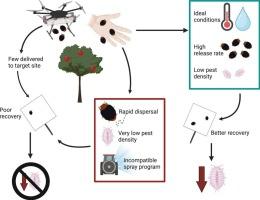孟氏隐毛虫无人机与地面释放防治苹果粉蚧效果评价
IF 3.4
2区 农林科学
Q2 BIOTECHNOLOGY & APPLIED MICROBIOLOGY
引用次数: 0
摘要
在华盛顿州(美国)的苹果种植区,粉蚧暴发不常见,但可能很严重,特别是在有机生产系统中。由于喷洒杀虫剂对这种害虫无效,管理策略有限,需要与有机做法兼容的替代方法。在4个试验(2020-2023年)中,我们评估了在商业有机苹果园中,粉蚧消灭剂隐翅目:粉蚧科(Cryptolaemus montrouzieri Mulsant)对葡萄粉蚧(Pseudococcus maritimus Ehrhorn)(半翅目:Pseudococcidae)的释放情况。虽然montrouzieri以其在世界各地各种种植制度中对粉蚧害虫的经典生物防治作用而闻名,但这是其在美国苹果园中作为增效生物防治的首次报道。测试了不同的应用类型(无人机与手动释放)、时间、生命阶段(成虫与幼虫)和比率。2020年,与未经处理的对照相比,季初的高释放率(12,355/公顷)减少了海洋假蝇,但在随后的年份没有观察到任何效果;在这些试验中,虫害压力也较低。在四年的研究中,montrouzieri成虫迅速地从野外散布出去,尤其是在无人机的释放下。需要进一步的研究来评估在粉蚧“热点地区”释放幼虫是否有效。基于它们的扩散倾向、寄主密度依赖性和代价,不支持释放成虫来控制苹果上的海蝇。本文章由计算机程序翻译,如有差异,请以英文原文为准。

Evaluation of drone and ground releases of Cryptolaemus montrouzieri for mealybug (Pseudococcus maritimus) control in apples
In apple growing regions of Washington State (USA), mealybug outbreaks are infrequent but can be severe, especially in organic production systems. Because insecticide sprays are ineffective for this pest, management tactics are limited, and alternative approaches that are compatible with organic practices are needed. In four trials (2020–2023), we evaluated releases of mealybug destroyers, Cryptolaemus montrouzieri Mulsant (Coleoptera: Coccinellidae), for the control of grape mealybug, Pseudococcus maritimus (Ehrhorn) (Hemiptera: Pseudococcidae), in commercial organic apple orchards. Although C. montrouzieri are well known for their role in classical biological control of mealybug pests in a variety of cropping systems worldwide, this is the first report of their use as augmentative biocontrol in apple orchards in the US. Different application types (drone vs hand-releases), timings, life stages (adults vs larvae), and rates were tested. In 2020, early season hand releases at high rates (12,355/ha) reduced P. maritimus relative to the untreated control, but in subsequent years no efficacy was observed; pest pressure was also lower in these trials. Across all four years of the study, C. montrouzieri adults dispersed rapidly from field sites, especially in drone releases. Further research is needed to assess if larval releases in mealybug “hot spots” can be effective. Based on their propensity for dispersal, high host-density dependence, and expense, releases of adult C. montrouzieri for P. maritimus control in apple are not strongly supported.
求助全文
通过发布文献求助,成功后即可免费获取论文全文。
去求助
来源期刊

Biological Control
生物-昆虫学
CiteScore
7.40
自引率
7.10%
发文量
220
审稿时长
63 days
期刊介绍:
Biological control is an environmentally sound and effective means of reducing or mitigating pests and pest effects through the use of natural enemies. The aim of Biological Control is to promote this science and technology through publication of original research articles and reviews of research and theory. The journal devotes a section to reports on biotechnologies dealing with the elucidation and use of genes or gene products for the enhancement of biological control agents.
The journal encompasses biological control of viral, microbial, nematode, insect, mite, weed, and vertebrate pests in agriculture, aquatic, forest, natural resource, stored product, and urban environments. Biological control of arthropod pests of human and domestic animals is also included. Ecological, molecular, and biotechnological approaches to the understanding of biological control are welcome.
 求助内容:
求助内容: 应助结果提醒方式:
应助结果提醒方式:


